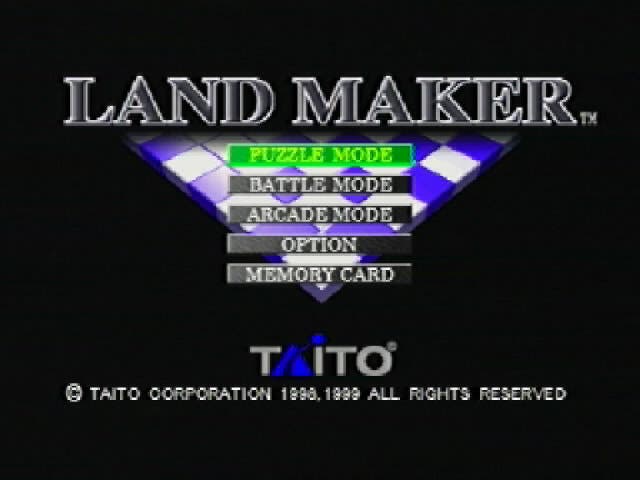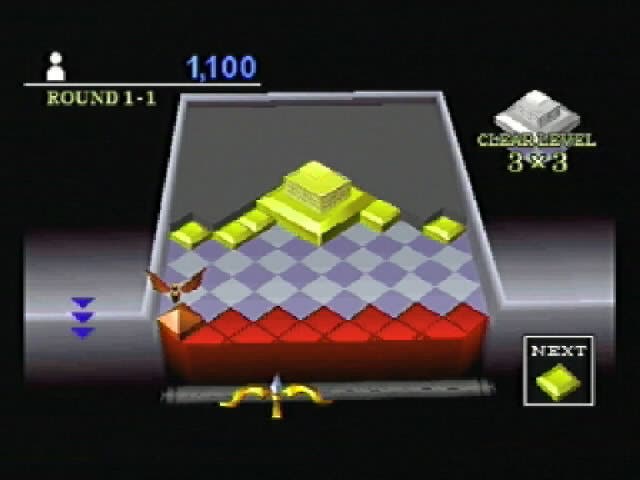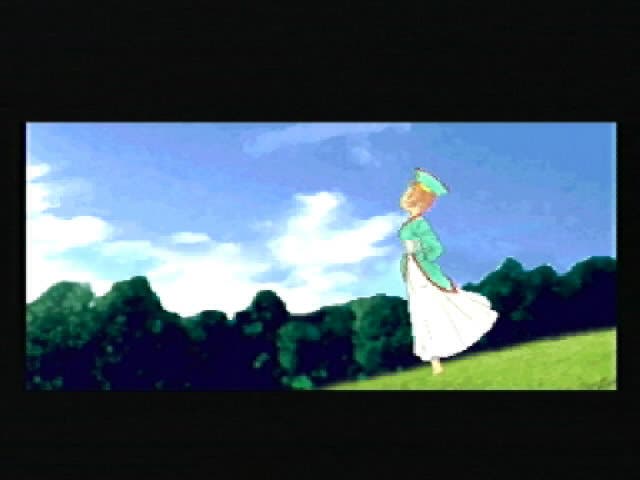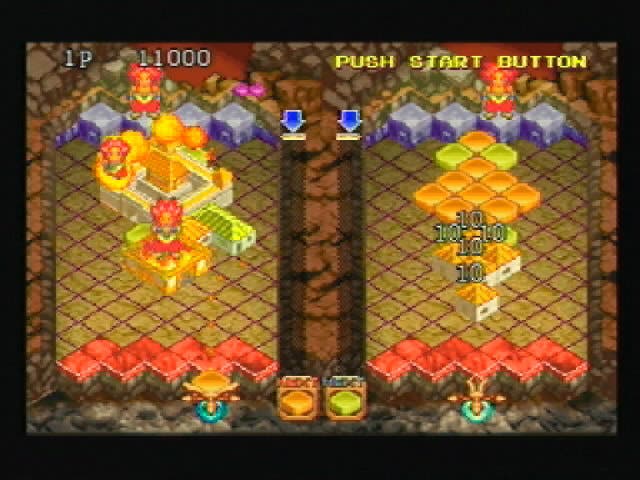Land Maker
Should Japanese puzzle games be translated with such vigour these days? Not every game's a Tetris or a Puyo Puyo, and sadly Land Maker is a cautionary tale to this effect.

Urban myth
Land Maker is the sort of puzzle game that should never have been released outside of Japan. It's a fair enough concept with nice visuals and execution, but the translation is dire at times, on and off the screen. It may sound silly, but the notion is that you are building houses from blocks, with the emphasis on being quicker than your opponent, or in single player Mode to build a city. The manual that accompanies the game is a minefield of involuntary patronization and confusion, in keeping with the direness of the translation. Here are a few choice excerpts - please bear in mind that these are direct quotes.. "What is a block? It is a coloured block which appears during the game." "How to change the colour of the blocks. If a block is placed near another one, this latter will change colour, assuming the one of the block shot against it. If the new colour is already present, buildings will increase in size." Of most amusement to the EuroGamer staff was the "What is a deadline?" section, during the course of which for some reason the incompetent translators mistakenly included the word "MISS" instead of "LOSE". There are plenty of options to the game, including Puzzle and Battle Modes, which are drawn in a 3D style, as well as a port of the original 2D Puzzle Bobble-style Arcade version. Rather like an upside down version of Tetris, you have to build houses by bashing blocks together.

Play Modes
Puzzle Mode is about as simplistic as the game gets. You have a 3-dimensional base and have to create buildings of increasing size under harsh conditions to construct a city, level by level. The first levels are easy, requiring only small buildings to win, but the lattermost levels are fiendishly difficult. If you manage to grab the highest score in a single location, a hidden one will appear in addition to the six available at the start, and as such the game offers incrementally more complex challenges to overcome. The, er, deadline we mentioned earlier is actually rather important, as if your building hits the deadline you lose. Similarly, if the space left on the board is too small to fit the necessary building your forfeiture of the round is immediate. Battle Mode is a fairly basic variation, allowing you to battle against CPU-controlled opponents on the 3-dimensional stage to build the biggest buildings. Coin-collection is the most important aspect, and you do this by building bigger, and once you have collected 100 coins, a symbol appears. Hit this and you win. The crux is that your opponent is often more deftly skilled than you and manages to get their first. The later levels are horrifyingly tricky! I suppose at this point you're more than a little confused as to why I think this game is unsuitable for Western audiences. Do continue, gentle reader, for all will be revealed!

Arcade foolishness!
Arcade Mode is where I imagine you'll put in the most hours, as I have. The single player games are quite entertaining, and playing Battle Mode against a friend can be Moderately enjoyable, but the real juice of the game lies in the hurly burly over the top nature of its classic Arcade Mode. So what's the problem? Well for starters, in order to retain the true feel of the arcade Mode, the superior 3-dimensional platform has been dropped in favour of flat 2-dimensional isometric guff quite frankly. I've heard of bad design decisions but there aren't enough adjectives in the world to describe how annoying I find this.. The 3D look is superb and vastly preferable, and the implementation elsewhere proves this, but by shunning it for the Arcade Mode developers Taito simply make themselves look like lazy slackers. On the GameBoy or another handheld unit maybe this would have been appropriate, but on the PlayStation, even though it is now fairly outdated it just doesn't make sense. The other problem is that without the flashy 3D graphics it can be harder to follow. You don't get the sense of depth and because of this the discerning the colour of the blocks behind the buildings can be difficult, especially since they are often yellow next to green or some similar combination such as that. In the heat of the battle not being able to distinguish the colour of the blocks can make you hesitant, and the game is definitely about speed of execution. As such you lose out.

Anime(tion)
The style of the game's characters is distinctly anime in nature. The slightly washed out look of the cut-scenes between matches is very impressionistic at times, and similar to games like Secret of Mana 2 from yesteryear. While some other anime-stylised puzzle gamers prefer the richly coloured cells of Puyo Puyo and its ilk, I find this more mature feel to be deeply gratifying. Sadly the sounds let Land Maker down as well. The happy beeps and squeaks of the blocks crashing together and incomprehensible Japanese pseudo-speak over the top is quite entertaining, but the dull methodical background music does nothing for me. Often I turned down the music and played some CDs on my hi-fi while testing it. In a way that's Land Maker's biggest flaw. By the time you've played through it enough to get a hold of the concept, you lose interest. Games like Wetrix and Puyo Puyo are intrinsically addictive because of their simplistic nature. Getting the hang of them is never an issue, but with Land Maker it is, and at £20-30 it doesn't represent a terribly good investment.
Conclusion
Land Maker is a bit of a catch-22. It's a nice, playable game at times and visually quite appealing, but a couple of design decisions and some dodgy background music immediately put you at odds with it, and even though you may persevere it never becomes as enjoyable as say Puzzle Bobble, from which it was clearly derived. If you're looking for something new, perhaps give it a try, but otherwise, take a look at the most recent Bust-a-Move title or head back down to your local arcade and see how it's done for real.








